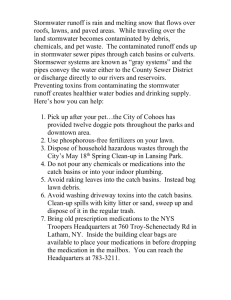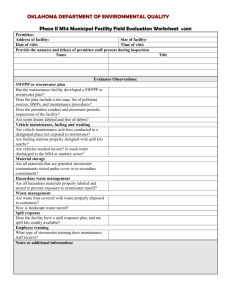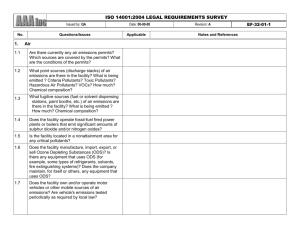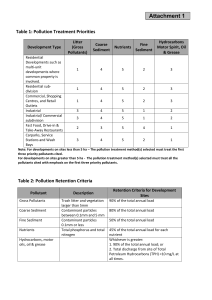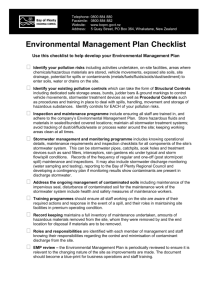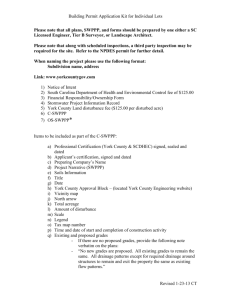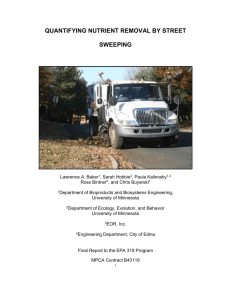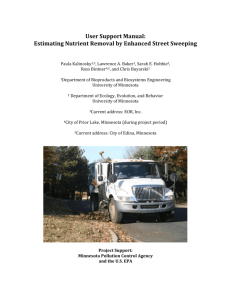Municipal Facility Inventory Procedure
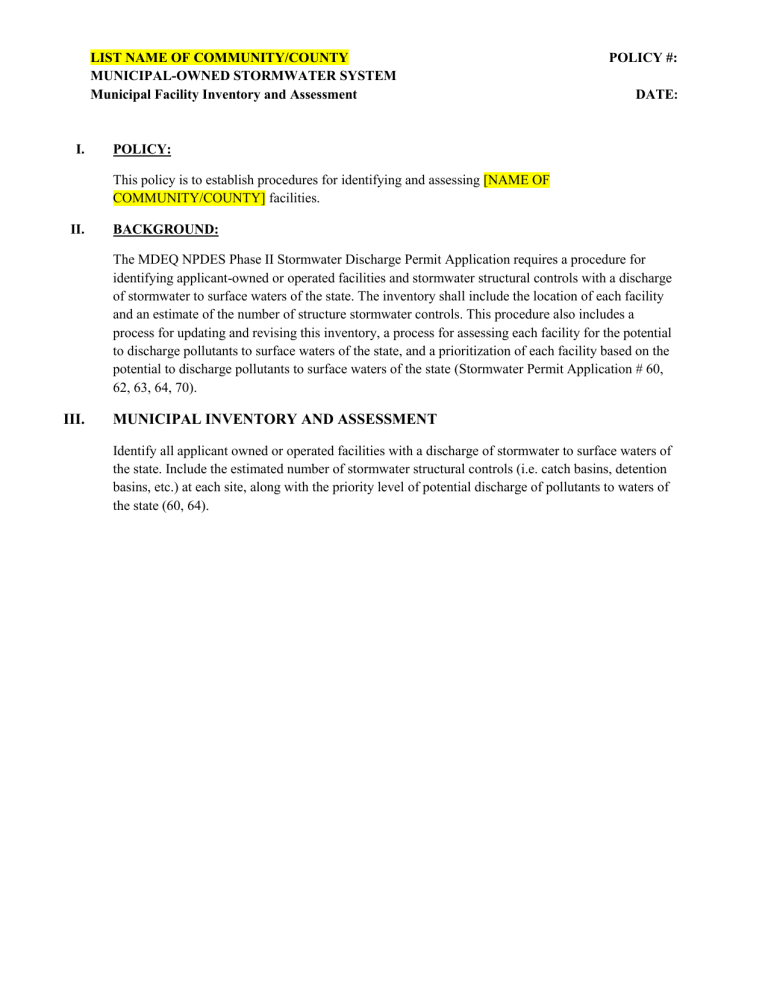
LIST NAME OF COMMUNITY/COUNTY
MUNICIPAL-OWNED STORMWATER SYSTEM
Municipal Facility Inventory and Assessment
I.
POLICY:
This policy is to establish procedures for identifying and assessing [NAME OF
COMMUNITY/COUNTY] facilities.
POLICY #:
DATE :
II.
BACKGROUND:
The MDEQ NPDES Phase II Stormwater Discharge Permit Application requires a procedure for identifying applicant-owned or operated facilities and stormwater structural controls with a discharge of stormwater to surface waters of the state. The inventory shall include the location of each facility and an estimate of the number of structure stormwater controls. This procedure also includes a process for updating and revising this inventory, a process for assessing each facility for the potential to discharge pollutants to surface waters of the state, and a prioritization of each facility based on the potential to discharge pollutants to surface waters of the state (Stormwater Permit Application # 60,
62, 63, 64, 70).
III.
MUNICIPAL INVENTORY AND ASSESSMENT
Identify all applicant owned or operated facilities with a discharge of stormwater to surface waters of the state. Include the estimated number of stormwater structural controls (i.e. catch basins, detention basins, etc.) at each site, along with the priority level of potential discharge of pollutants to waters of the state (60, 64).
LIST NAME OF COMMUNITY/COUNTY
MUNICIPAL-OWNED STORMWATER SYSTEM
Municipal Facility Inventory and Assessment
POLICY #:
DATE :
Facility Name
(Examples to include)
Administration building
Animal control building
Airport
Bus garage
Cemetery
Composting facility
Estimated # of
Stormwater
Structural
Controls
Priority
Level of
Potential
Discharge*
(High, Med,
Low)
Presence of
Assessment
Factors**
BMP’s Implemented
to reduce pollutant runoff at Med or
Low priority facilities
Low
Med
Med
High
Low
Med
0
1, 3
1, 3
1, 3, 4
0
1, 3, 4
Catch basin cleaning, street sweeping
Catch basin cleaning, animal pens directed to drain to vegetated area, pens cleaned twice daily
Catch basin cleaning, street sweeping, bioswales
See SWPPP
Catch basin cleaning, street sweeping
Catch basin cleaning, CB inserts, concrete blocks to prevent erosion of piles, street sweeping
Equipment storage and/or maintenance facility
High 1, 3, 4 See SWPPP
Fire stations
Fuel farms
Low
Med
0
1, 4
Catch basin cleaning, street sweeping
Catch basin cleaning, spill kits, high level alarms, street sweeping
Hazardous waste disposal/handling/transfer facilities
Landfills
Landscape maintenance facility
Libraries
Materials storage yard
High
High
High
Low
High
1, 3, 4
1, 4
1, 3, 4
0
1, 3, 4
See SWPPP
See SWPPP
See SWPPP
Catch basin cleaning, street sweeping
See SWPPP
LIST NAME OF COMMUNITY/COUNTY
MUNICIPAL-OWNED STORMWATER SYSTEM
Municipal Facility Inventory and Assessment
POLICY #:
DATE :
Mosquito control facility
Parks
Pesticide storage facilities
Police stations
Public golf courses
Public schools
Med
Low
High
Low
Low
Low
1, 3, 4
0
1, 3, 4
0
0
0
Catch basin cleaning, spill kits, street sweeping
Catch basin cleaning, street sweeping
See SWPPP
Catch basin cleaning, street sweeping
Catch basin cleaning, street sweeping
Catch basin cleaning, street sweeping
Public works/services facility
High 1, 3, 4 See SWPPP
Recycling facilities
Salt storage yard (if separate from public works yard)
Med
High
1, 3, 4
1, 3, 4
Catch basin cleaning, street sweeping, spill kits
See PIPP
Solid waste handling/transfer facility
High 1, 3, 4 See SWPPP
Other:
*For facilities that have a high potential to discharge pollutants to surface waters of the state, a standard operating procedure (SOP) must be developed for that facility identifying the controls put in place to reduce pollutant runoff. This SOP could be a Stormwater Pollution Prevention Plan (SWPPP) for municipal garage and/or Pollution Incident Prevention Plan (PIPP) for salt storage facilities. See separate SOP/SWPPP review document for more details.
**For facilities that have a medium or low potential for the discharge of pollutants to surface waters of the state, each facility was evaluated for the presence of the following factors (63):
0.
Absence of any factors
1.
Presence of urban pollutants stored at the site (i.e. sediment, nutrients, metals, hydrocarbons, pesticides, fertilizers, herbicides, chlorides, trash, bacteria, or other site-specific pollutants
2.
Identification of improperly stored materials
3.
Potential for polluting activities to be conducted outside (i.e. vehicle washing)
4.
Proximity to waterbodies
5.
Poor housekeeping practices
6.
Discharge of pollutants of concern to impaired waters
LIST NAME OF COMMUNITY/COUNTY
MUNICIPAL-OWNED STORMWATER SYSTEM
Municipal Facility Inventory and Assessment
POLICY #:
DATE :
This inventory will be updated within 30 days as facilities and structural stormwater controls are added, removed, or no longer owner or operated by the applicant (62). Priority level assessments will be revised within 30 days prior to discharging stormwater at a new facility, or when new the storage of materials, equipment, or vehicles changes at a facility (63).
Best Management Practices (BMPs) were identified for each facility with low or medium potential to discharge pollutants to surface waters of the state. For all low facilities where no assessment factors are present, catch basin cleaning and street sweeping will be performed as indicating in the applicable procedures for these activities. For all medium facilities, the appropriate BMPs were considered based on the assessment factor present to prevent or minimize the potential for pollutants from entering surface waters of the state (70).
